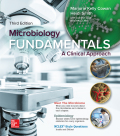
Microbiology Fundamentals: A Clinical Approach
3rd Edition
ISBN: 9781260163698
Author: Cowan
Publisher: MCG
expand_more
expand_more
format_list_bulleted
Concept explainers
Question
Chapter 16.4, Problem 8AYP
Summary Introduction
To describe:
The important anatomical features of the eye.
Concept introduction
Eye is hollow, spherical visualizing organ of about 2.5 cm (centimeters). It provides the ability to the organism to receive and analyze the visual details. The hole of the eye located in the middle of iris is known as pupil that allows the light to strike on the retina.
Expert Solution & Answer
Want to see the full answer?
Check out a sample textbook solution
Students have asked these similar questions
glg 112 mid unit assignment Identifying melting processes
Give only the mode of inheritance consistent with all three pedigrees and only two reasons that support this, nothing more, (it shouldn't take too long)
O
Chapter 16 Solutions
Microbiology Fundamentals: A Clinical Approach
Ch. 16.1 - Describe the important anatomical features of the...Ch. 16.1 - Prob. 2AYPCh. 16.1 - Prob. 1NPCh. 16.2 - Prob. 3AYPCh. 16.3 - Prob. 4AYPCh. 16.3 - Prob. 5AYPCh. 16.3 - Prob. 6AYPCh. 16.3 - Prob. 7AYPCh. 16.3 - Prob. 2NPCh. 16.3 - Prob. 3NP
Ch. 16.3 - Prob. 1MMCh. 16.3 - Prob. 2MMCh. 16.3 - Prob. 4NPCh. 16.4 - Prob. 8AYPCh. 16.4 - Prob. 9AYPCh. 16.5 - List the types of normal biota presently known to...Ch. 16.6 - Prob. 11AYPCh. 16.6 - Prob. 12AYPCh. 16.6 - Prob. 5NPCh. 16 - Prob. 1QCh. 16 - Can you think of a plausible argument for why...Ch. 16 - Prob. 3QCh. 16 - Prob. 4QCh. 16 - What cell structure of Bacillus anthracis makes it...Ch. 16 - Prob. 6QCh. 16 - Which of the following organisms produces an...Ch. 16 - Prob. 8QCh. 16 - Prob. 9QCh. 16 - Prob. 10QCh. 16 - Prob. 11QCh. 16 - Prob. 12QCh. 16 - Which of the following conditions is most likely...Ch. 16 - Prob. 14QCh. 16 - Prob. 15QCh. 16 - Prob. 16QCh. 16 - Prob. 17QCh. 16 - Prob. 18QCh. 16 - Prob. 19QCh. 16 - Explain why detecting a single case of smallpox...Ch. 16 - Prob. 21QCh. 16 - From chapter 11, figure 11.2. How does this figure...
Knowledge Booster
Learn more about
Need a deep-dive on the concept behind this application? Look no further. Learn more about this topic, biology and related others by exploring similar questions and additional content below.Similar questions
- Describe the principle of homeostasis.arrow_forwardExplain how the hormones of the glands listed below travel around the body to target organs and tissues : Pituitary gland Hypothalamus Thyroid Parathyroid Adrenal Pineal Pancreas(islets of langerhans) Gonads (testes and ovaries) Placentaarrow_forwardWhat are the functions of the hormones produced in the glands listed below: Pituitary gland Hypothalamus Thyroid Parathyroid Adrenal Pineal Pancreas(islets of langerhans) Gonads (testes and ovaries) Placentaarrow_forward
- Describe the hormones produced in the glands listed below: Pituitary gland Hypothalamus Thyroid Parathyroid Adrenal Pineal Pancreas(islets of langerhans) Gonads (testes and ovaries) Placentaarrow_forwardPlease help me calculate drug dosage from the following information: Patient weight: 35 pounds, so 15.9 kilograms (got this by dividing 35 pounds by 2.2 kilograms) Drug dose: 0.05mg/kg Drug concentration: 2mg/mLarrow_forwardA 25-year-old woman presents to the emergency department with a 2-day history of fever, chills, severe headache, and confusion. She recently returned from a trip to sub-Saharan Africa, where she did not take malaria prophylaxis. On examination, she is febrile (39.8°C/103.6°F) and hypotensive. Laboratory studies reveal hemoglobin of 8.0 g/dL, platelet count of 50,000/μL, and evidence of hemoglobinuria. A peripheral blood smear shows ring forms and banana-shaped gametocytes. Which of the following Plasmodium species is most likely responsible for her severe symptoms? A. Plasmodium vivax B. Plasmodium ovale C. Plasmodium malariae D. Plasmodium falciparumarrow_forward
- please fill in missing parts , thank youarrow_forwardplease draw in the answers, thank youarrow_forwarda. On this first grid, assume that the DNA and RNA templates are read left to right. DNA DNA mRNA codon tRNA anticodon polypeptide _strand strand C с A T G A U G C A TRP b. Now do this AGAIN assuming that the DNA and RNA templates are read right to left. DNA DNA strand strand C mRNA codon tRNA anticodon polypeptide 0 A T G A U G с A TRParrow_forward
arrow_back_ios
SEE MORE QUESTIONS
arrow_forward_ios
Recommended textbooks for you
 Principles Of Radiographic Imaging: An Art And A ...Health & NutritionISBN:9781337711067Author:Richard R. Carlton, Arlene M. Adler, Vesna BalacPublisher:Cengage Learning
Principles Of Radiographic Imaging: An Art And A ...Health & NutritionISBN:9781337711067Author:Richard R. Carlton, Arlene M. Adler, Vesna BalacPublisher:Cengage Learning Human Physiology: From Cells to Systems (MindTap ...BiologyISBN:9781285866932Author:Lauralee SherwoodPublisher:Cengage Learning
Human Physiology: From Cells to Systems (MindTap ...BiologyISBN:9781285866932Author:Lauralee SherwoodPublisher:Cengage Learning Comprehensive Medical Assisting: Administrative a...NursingISBN:9781305964792Author:Wilburta Q. Lindh, Carol D. Tamparo, Barbara M. Dahl, Julie Morris, Cindy CorreaPublisher:Cengage Learning
Comprehensive Medical Assisting: Administrative a...NursingISBN:9781305964792Author:Wilburta Q. Lindh, Carol D. Tamparo, Barbara M. Dahl, Julie Morris, Cindy CorreaPublisher:Cengage Learning


Principles Of Radiographic Imaging: An Art And A ...
Health & Nutrition
ISBN:9781337711067
Author:Richard R. Carlton, Arlene M. Adler, Vesna Balac
Publisher:Cengage Learning

Human Physiology: From Cells to Systems (MindTap ...
Biology
ISBN:9781285866932
Author:Lauralee Sherwood
Publisher:Cengage Learning


Comprehensive Medical Assisting: Administrative a...
Nursing
ISBN:9781305964792
Author:Wilburta Q. Lindh, Carol D. Tamparo, Barbara M. Dahl, Julie Morris, Cindy Correa
Publisher:Cengage Learning

12 Organ Systems | Roles & functions | Easy science lesson; Author: Learn Easy Science;https://www.youtube.com/watch?v=cQIU0yJ8RBg;License: Standard youtube license